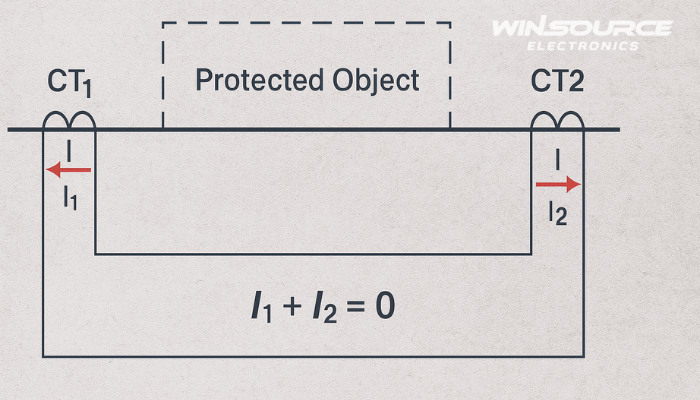
* Question
What is the basic principle of the longitudinal current differential protection?
* Answer
The basic principle of longitudinal current differential protection (also called line differential protection) is based on Kirchhoff’s Current Law (KCL) — that the algebraic sum of currents entering and leaving a protected section should be zero under normal operating conditions.
If a difference exists between these currents, it indicates that a fault has occurred within the protected zone.
1. Principle Overview
In longitudinal current differential protection, the currents at both ends of a transmission line (or any protected element such as a transformer or busbar) are measured and compared in real time.
Under normal operation or external faults, the current entering the protected zone equals the current leaving it.
Under an internal fault (e.g., short circuit inside the protected line), the current entering and leaving no longer match — their vector difference (differential current) becomes significant, triggering a trip signal.
2. Operating Principle (Based on KCL)
Let:
I1 = current entering the line at terminal A
I2 = current leaving the line at terminal B
Then the differential current is:
Idiff=I1+I2
For normal or external faults: Idiff≈0
For internal faults: Idiff≠0
When Idiff exceeds a preset threshold, the relay determines an internal fault and trips both circuit breakers to isolate the faulted section.
3. Key Components
Current Transformers (CTs): Installed at both ends of the protected line to measure current magnitudes and phases.
Communication Channel: Transfers current or current-derived signals between terminals for comparison (often via fiber optics in modern systems).
Differential Relay: Compares currents and issues a trip command when a differential current is detected.
4. Types of Longitudinal Differential Protection
Conventional (Pilot-Wire) Differential Protection
Uses direct wired communication (pilot wires) between terminals.
Suitable for short transmission lines.
Digital (Numerical) Differential Protection
Each terminal samples current digitally; data are exchanged over communication links.
Suitable for long-distance and high-voltage transmission lines.
Provides high sensitivity and fast operation.
5. Advantages
Selective: Operates only for internal faults.
Fast and sensitive: Detects faults almost instantaneously.
Unaffected by system impedance or fault current direction.
High reliability with modern digital communication links.
6. Limitations
Requires a reliable and synchronized communication channel between line ends.
Sensitive to CT saturation or mismatch, which may cause false trips if not compensated.
Higher cost and complexity for long-distance applications.
7. Summary
Condition | Current Relation | Differential Current | Action |
Normal Operation | I1= −I2 | ≈ 0 | No trip |
External Fault | I1≈−I2 | Small (due to CT errors) | No trip |
Internal Fault | I1+I2≠0 | Large | Trip |
In summary:
The longitudinal current differential protection detects faults by comparing the instantaneous currents entering and leaving a protected section. Any significant difference indicates an internal fault, causing the relay to isolate the faulted part quickly and selectively.

COMMENTS